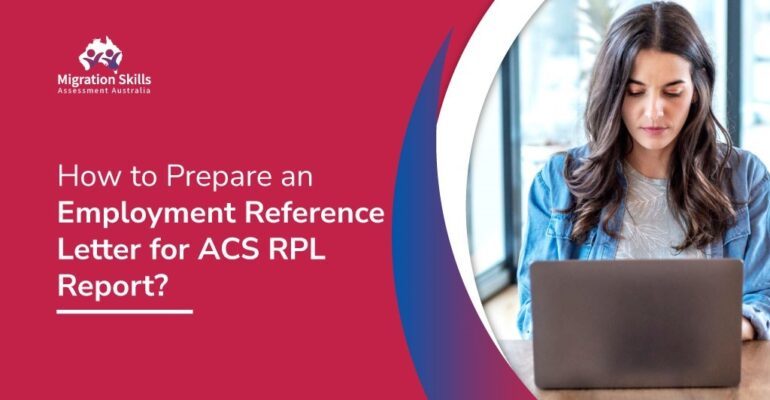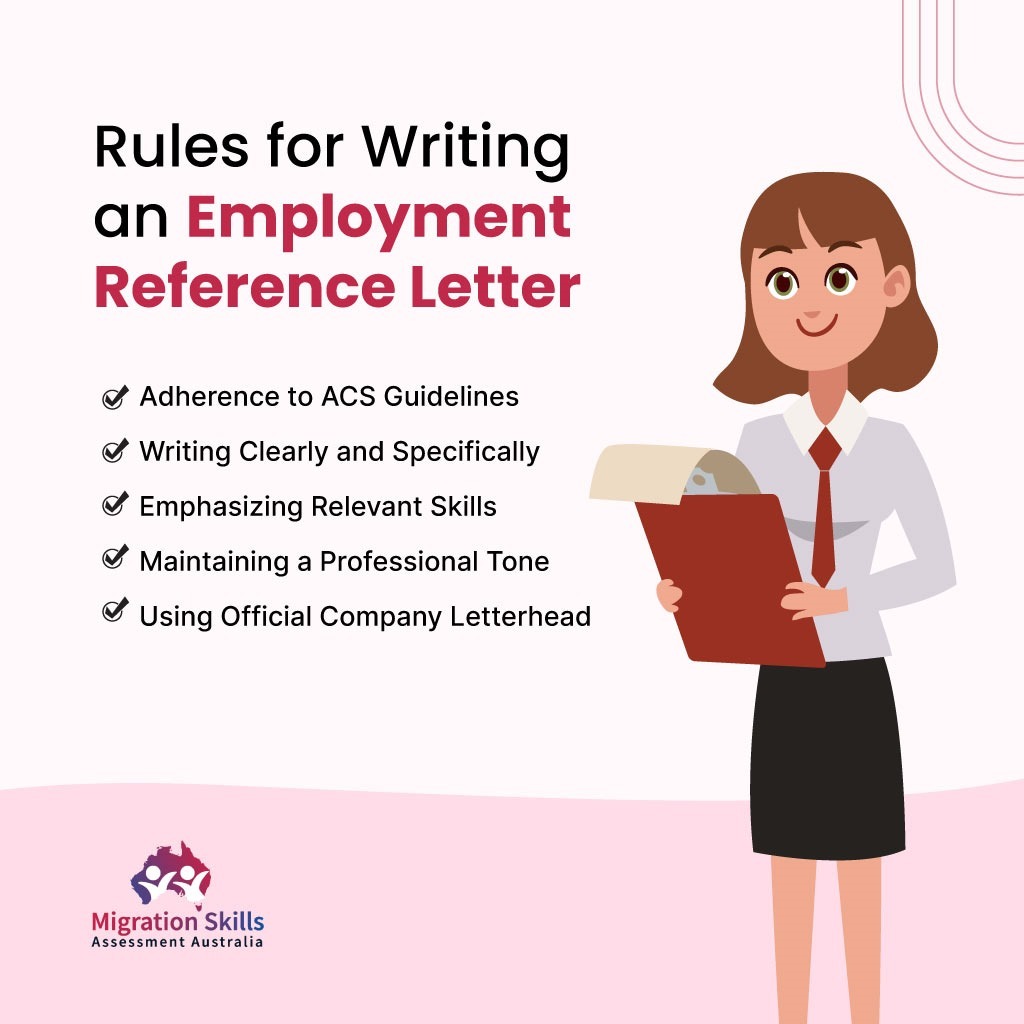How to prepare an Employment Reference Letter for the ACS RPL Report?

How to prepare an Employment Reference Letter for the ACS RPL Report?
Do you want to boost your career in Australia’s growing Information and Communication Technology (ICT) field? If you have the skills but need more formal qualifications, the Australian Computer Society (ACS) Recognition of Prior Learning (RPL) process could be your pathway to success.
At the core of this process is the Employment Reference Letter. It’s a document that confirms your professional background and technical skills in your chosen ICT field.
In this detailed blog, we will develop the skill of creating a robust Employment Reference Letter for your ACS RPL report. But first, let’s understand why this document holds such significance in the RPL assessment process.
Why are Employment Reference Letters important for the ACS RPL Report?
The ACS uses the Employment Reference Letter to check your qualifications and skills for your chosen ICT job. This letter lets you show your practical experience, even if you don’t have formal qualifications. A well-prepared Employment Reference Letter backs up what you say and helps prove you’re eligible.
The ACS RPL process helps ICT professionals show they’re good at their jobs when they need recognized qualifications. Your Employment Reference Letter is essential for showing you’re a good fit for working or moving to Australia’s ICT industry. That’s why it’s crucial to understand how to make a strong letter.
Employment Reference Letter Format
Before discussing how to make a good Employment Reference Letter, let’s first see what needs to be in it, following the ACS guidelines.
1. Date of Employment
Your reference letter should begin by specifying the date you began your employment with the organization. This date offers context about your tenure.
2. Job Position
State the job title you held during your employment with the organization. This information aids the ACS in assessing your professional background.
3. Roles and Responsibilities
This section is the main section of the letter and should describe your job responsibilities and tasks. It’s where you showcase your day-to-day duties, emphasizing those relevant to your chosen ICT occupation.
4. Work Hours
In this section, specify the nature of your employment and work hours. State whether it was full-time, part-time, contract-based, or another arrangement. This information is crucial for the ACS’s assessment.
5. Country of Employment
Mention the country where you got employed by the organization. This step helps the ACS understand the international context of your experience.
Read more: Competency Demonstration Report (CDR): Everything you need to know. 📑📑
Tips to Prepare an Employment Reference Letter
To write a persuasive Employment Reference Letter, pay close attention to details and follow ACS guidelines. Here are some essential tips to help you prepare an outstanding letter:
1. Understanding the Essential Components
To meet ACS standards in your Employment Reference Letter, be sure to include these essential elements:
Detailed Personal Information
- Employer Information
- Professional Background
- Job Responsibilities and Tasks
- Achievements and Contributions
- Statement of Skills
- Signature and Contact Information
- On Official Company Letterhead
These elements clearly show your job history and how it relates to your chosen ICT career.
2. Addressing the ACS Assessing Authority
Address the reference letter to the ACS Assessing Authority. You can find the correct address on the ACS website or RPL guidelines. Proper addressing ensures your letter reaches its intended destination.
3. Gathering Relevant Information
Before you begin writing, gather all the essential details about your job at the organization:
- An employment contract or appointment letter.
- Performance appraisals, if available.
- Project reports or documentation.
- Any other relevant documentation.
Having these materials on hand ensures that your letter is accurate and thorough.
– Writing the Letter
Now, you can begin drafting the letter. Follow these guidelines for an effective letter:
– Opening Paragraph
- Start with a polite salutation.
- Include your full name, current contact information, and the letter’s purpose (ACS RPL application).
Introduction
- Introduce your previous employer, including their name, official address, and the date of the letter.
Job Position and Duration
- Mention your job title during your tenure with the company.
- Specify the exact duration of your employment, including the start and end dates.
- State the type of employment (e.g., full-time, part-time, contract).
Detailed Job Responsibilities
- Dedicate a large part of the letter detailing your job responsibilities and tasks.
- Use concise and clear language to describe your role, focusing on ICT-related duties.
- Emphasize any specialized skills or knowledge you applied during your employment.
- Describe your role in any decision-making processes, problem-solving, or team collaborations.
Highlighting Achievements
- Spotlight any achievements or contributions you made during your tenure.
- These details should be measurable, like completed projects, cost savings, and process improvements.
- Explain how these achievements benefited the organization.
Statement of Skills
- Include a section that mentions your skills and competencies relevant to your chosen ICT occupation. Ensure this aligns with the ACS requirements for your occupation.
– Conclusion and Signature
- End the letter by expressing your appreciation for the chance or opportunity to work with the company.
- Request your previous employer’s signature in ink.
- Include their contact information for verification.
– Proofreading and Verification
After drafting the letter, proofread it to ensure accuracy and completeness. Check for any errors in dates, job titles, or other essential details. A well-structured and error-free document reflects professionalism.
– Requesting a Signature
Send the draft to your previous employer and request their signature on the letter. Be prepared to provide any more information or clarification they may need.
– Keeping a Copy
Remember to keep a copy of the Employment Reference Letter for future reference or applications. Pay close attention to these tips to ensure your letter meets ACS requirements and is effective.
Visit: How to make an ideal CV for a skills assessment? ✈️✈️
Rules for Writing an Employment Reference Letter
Besides the things we talked about before, make sure to follow specific rules when you write your Employment Reference Letter. These rules ensure that your letter meets the ACS’s standards and expectations.

1. Adherence to ACS Guidelines
The ACS has established clear guidelines for the format and content of Employment Reference Letters. It’s imperative to adhere to these guidelines. The ACS may only accept your letter if you deviate from the prescribed format or omit necessary information.
2. Writing Clearly
Write the letter in a specific manner. Avoid vague or ambiguous language. Ensure that the reader can understand your job responsibilities and contributions. Specificity is crucial in demonstrating the relevance of your experience to your chosen ICT occupation.
3. Emphasizing Relevant Skills
In your Employment Reference Letter, highlight the skills and competencies related to your chosen ANZSCO (Australian and New Zealand Standard Classification of Occupations) code. The ACS evaluates your qualifications based on these skills, making matching your experience with their criteria vital.
4. Maintaining a Professional Tone
Throughout the letter, maintain a professional and respectful tone. Avoid using language that could come across as unprofessional or disrespectful. Remember that this letter is an official document representing your qualifications and experience.
5. Using Official Company Letterhead
Print the Employment Reference Letter on the official letterhead of the company where you worked. This action adds credibility to the document and confirms its authenticity.
You can guarantee that your Employment Reference Letter meets the ACS’s standards and shows your qualifications and experience in the best way.
Read more: Skillselect Visa Categories. 📑📑
Scenarios for Unacceptable Work Experience
Knowing when the ACS might say no to your work experience is vital, even though the RPL process counts on the Employment Reference Letter. Knowing these situations can help you overcome challenges and strengthen your RPL application.
1. When Concurrent Employment is a Challenge
The ACS does not consider concurrent employment when assessing your work experience. Concurrent employment refers to holding many jobs.
If you have concurrent jobs simultaneously, pick one main job for your RPL application and submit a reference letter for that particular position.
2. Dealing with Work Experience Outside Your Field
The ACS evaluates your qualifications based on their relevance to your nominated ANZSCO field. If your work experience doesn’t relate to this field, the ACS might not assess or consider it during the RPL process. Choose the experience that fits your job and write a reference letter emphasizing its importance.
3. Importance of Documentation
If your documents don’t match the ACS guidelines or are incomplete, the ACS may not assess your work experience. However, if your reference letter has the necessary info or if you can provide supporting documents, they might review your experience. So, make sure your reference letter is detailed and backed by the right paperwork.
4. Ensuring Enough Detail
A lack of detail in an Employment Reference Letter may clarify your job responsibilities and contributions. If your letter is too brief or needs more specific information, the ACS might consider it unassessable.
Work with your former employer to avoid this to ensure the letter fully describes your experience. Knowing these situations can help you make wise choices when selecting work experience for your ACS RPL application.
It’s crucial to choose experience related to your chosen ICT occupation; a detailed reference letter can support it.
Visit: Application Pathways for Migration Skills Assessment ✈️✈️
Possible Reasons for ACS RPL Employment Reference Letter Rejection
Knowing why the ACS may reject your letter is essential when crafting your Employment Reference Letter. This understanding helps you avoid rejection and boosts your chances of a successful RPL application.
1. Incomplete or Inaccurate Information
The ANZSCO-designated job’s requirements should match the duties and responsibilities outlined in the reference letter. To avoid rejection due to insufficient information, at least 65% of the tasks should be consistent.
2. Non-Compliance with ACS Guidelines
The ACS has specific rules for how Employment Reference Letters should look and what they should say. To avoid rejection, follow ACS guidelines by addressing the letter and including all the needed information.
3. Lack of Relevance to Your ICT Occupation
If the work experience in your Employment Reference Letter doesn’t match your ICT occupation, the ACS might not assess it. To prevent this, choose an experience that fits your chosen field and highlight its relevance in the reference letter.
4. Insufficient Detail or Documentation
Your letter needs details and supporting documents. Work with your former employer to ensure your letter has what ACS needs for approval to get ACS approval.
Knowing these rejection reasons helps you create a better Employment Reference Letter. This assessment, in turn, improves your chances of success in your RPL application to the ACS.
Conclusion
Creating an Employment Reference Letter for your ACS RPL application is vital for your ICT career in Australia. But it can be complex, so getting it right is essential. If you need help or need help, consider reaching out to experts who know ACS RPL applications well.
Getting help from MigrationSkillsAustralia can make your RPL process simpler. They assist with your Employment Reference Letter, ensure your application is complete, and boost your chances of success. Consulting with migration experts or professional writers can make a big difference in your ACS RPL application.
Remember, the quality and accuracy of your Employment Reference Letter matter a lot for your ACS RPL assessment. By following the tips in this guide and seeking help from professionals when needed, you can work towards your ICT career goals in Australia.

